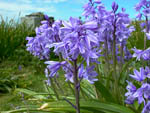What to do in the garden June 24
Country Life advises where your gardening energies are best placed this week


Well, The Laskett gardens are now regularly open and, to be honest, I'm enjoying the learning curve. All sorts of things arise that, until now, have passed me by. Visitors are mad about knowing the names of plants, so I've had to spend a fortune on lead labels, which are sprouting up all over the place to meet this desire.
Garden visitors tend to be elderly and that means seats are needed, so there's been a migration of them away from the house; it's called for careful consideration in terms of placing. Siting a garden seat is a hugely sensitive matter, for it must compose into any garden picture as if intended from the outset. I'm afraid that I refuse to place one where it will ruin a vista, although, from the visitor's point of view, that's precisely where they'd want to sit. I have a carefully worded screed that's emailed to any visiting group, warning them that there's no catering and only a solitary loo nestling next to an ancient summerhouse.
I had the outside constructed to look like a Victorian tool shed, the inside is gleaming white and moderne. My garden's visitors represent a fascinating variety of interests. I'm still puzzled how the Georgian Group-or, as my efficient helper billed them, the Georgina Group-managed to square
The Laskett with their sphere of interest. But what's cheering is how varied the parties are; they're by no means only garden clubs, but friends of museums, branches of the Art Fund and regional National Trust groups. And that means, when I greet them, I quickly have to reframe what I'm going to say to meet where a particular group is coming from intellectually. Before I begin my welcoming speech, I always ask whether they know anything about the garden. Almost without an exception, I'm met with a blank stare. It doesn't seem to occur to virtually any of them to Google it.
Putting that to one side, an open garden calls for far sharper maintenance. Even before it's reached its late-June fluffy stage, I've found myself clipping the box topiary to ensure the contrast with the surrounding swathes of grasses and perennials. Mowing also moves up the agenda, which makes me think: if you mow to open two days, you might just as well open the day between. But that decision awaits the post-mortem on year one.
I've found it odd, too, becoming a shopkeeper and learning that response to merchandise is entirely unpredictable. You can't go wrong with cats, I was told, and a group of postcards and notelets was duly produced celebrating The Laskett cats Muff, Larkin and Souci. But, alas, their wares produced no stampede of shoppers. And what I regard as a beautiful book bag seems to be languishing on the shelves. Plus, much to my chagrin, we're more than halfway through the opening season and the elegantly designed souvenir booklet has yet to arrive.
But then I did want something with a sense of romance about it, a touch of the Rex Whistlers and Cecil Beatons, as the garden was the embodiment of a marriage. But, yes, I love visitors who share and respond to the excitement and beauty of the garden. Familiarity with it has made me forget how extremely unusual and eccentric it is, with its columns, cat tombs, memorials to a lost Britain and dancing bears.
Exquisite houses, the beauty of Nature, and how to get the most from your life, straight to your inbox.
A visiting garden historian wrote that it recalled to him such extremely personal creations of 18th-century garden-makers, utterly unashamed about celebrating, in their patch, their political affiliations, their aesthetic predilections and events in their own lives. I try to appear as each group leaves and get clutched by the hand. I'm told that it's better than Hidcote or Highgrove. I wonder! Only history will tell.
Country Life is unlike any other magazine: the only glossy weekly on the newsstand and the only magazine that has been guest-edited by His Majesty The King not once, but twice. It is a celebration of modern rural life and all its diverse joys and pleasures — that was first published in Queen Victoria's Diamond Jubilee year. Our eclectic mixture of witty and informative content — from the most up-to-date property news and commentary and a coveted glimpse inside some of the UK's best houses and gardens, to gardening, the arts and interior design, written by experts in their field — still cannot be found in print or online, anywhere else.
